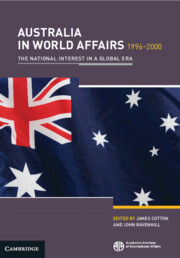Book contents
- Frontmatter
- Contents
- Figure
- Contributors
- Preface
- Abbreviations
- Part I Setting the Scene
- Part II Relationships
- Part III Issues
- 11 Facing an Uncertain Future: Defence and Security under the Howard Government
- 12 The East Timor Commitment and Its Consequences
- 13 Australia in World Environmental Affairs
- 14 Australia and the International Human Rights Regime1
- 15 Australia and the Global Economy
- 16 Australia and the Asian Economic Crisis
- References
- Index
16 - Australia and the Asian Economic Crisis
from Part III - Issues
Published online by Cambridge University Press: 04 May 2024
- Frontmatter
- Contents
- Figure
- Contributors
- Preface
- Abbreviations
- Part I Setting the Scene
- Part II Relationships
- Part III Issues
- 11 Facing an Uncertain Future: Defence and Security under the Howard Government
- 12 The East Timor Commitment and Its Consequences
- 13 Australia in World Environmental Affairs
- 14 Australia and the International Human Rights Regime1
- 15 Australia and the Global Economy
- 16 Australia and the Asian Economic Crisis
- References
- Index
Summary
Beginning with the floating of the Thai baht on 2 July 1997, a regional crisis unfolded that saw the magic disappear from the economies of East Asia. What appeared initially to be merely the sharp devaluation of a single currency turned into an economic free-fall that rippled across neighbouring economies and eventually the entire region. By early September 1997, the Malaysian ringgit had fallen to its lowest level against the US dollar since 1971; in the space of six months the Thai stock-market had lost 38 per cent of its value; Malaysia’s lost 44 per cent, the Philippines’ lost 35 per cent; Indonesia’s lost 17 per cent; and Japan’s lost 4 per cent. By year’s end, the Indonesian and South Korean economies had been brought to their knees, and speculation had begun that East Asia would drag the global economy into a bout of chronic deflation.
Keywords
- Type
- Chapter
- Information
- Australia in World Affairs 1996–2000The National Interest in a Global Era, pp. 208 - 223Publisher: Cambridge University PressFirst published in: 2024

